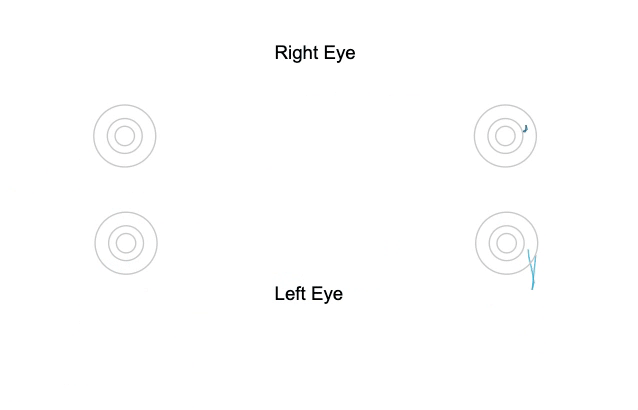
Neuro-Optometric Evaluation
Neuro-Optometry
A neuro-optometric examination is a comprehensive evaluation of all of the aspects of vision that may be affected by damage or abnormal development to the eyes and central nervous system. This includes evaluation of how the eyes see (visual acuity, color vision, contrast sensitivity, peripheral vision, ocular health), how the eyes work together and track as a team (eye turns/oculomotor), how the eyes function with head/body movement (vestibular-oculomotor, cervical-oculomotor), and how the brain interprets what the eyes see (visual processing).
The evaluation goes beyond the standard eye exam, and deep dives into the strength, accuracy, and endurance of each eye movement, as well as assessment of how the eyes and the ears (vestibular) and eyes and the neck/body work together to evaluate what is causing the patients symptoms.

Visual Acuity
Visual acuity (clarity) - Many patients have reduced or missing pieces of their vision after a head injury and/or stroke while others have 20/20 visual acuity but still feel that their vision is "off" or blurry. Some common visual acuity complaints we see in our practice include intermittent blur/fluctuating vision, blurry vision with head movement, blurry vision with eye movement, difficulty with blur after a prolonged amount of time or with specific visual tasks, halo of peripheral blur around objects, or blur due to oscillopsia (image movement due to nystagmus). A neuro-optometric evaluation takes a thorough evaluation to find the functional cause of your complaint so the doctor can discuss prognosis and management options.
The smallest thing you are able to see

Eye Health
Eye disease can contribute to visual symptoms. Patients with neurologic disorders like migraine, Parkinson's disease, and traumatic brain injury are more likely to have dry eye than the general population. Left untreated this can contribute to intermittent blur, eyestrain, and light sensitivity.
Other conditions of the eye like flashes of light, floaters, or vision loss can be due to disorders of the vitreous, retina, and/or optic nerve.
It is important that a comprehensive eye health exam is done to ensure that part of the visual symptoms are not coming from the eyeball itself.
At Virginia Neuro-Optometry, we know that many of you are referred by your local optometrist and ophthalmologist. We are happy to co-manage this service with them.
How healthy the eyes are

Oculomotor Function (Eye Movements)
It takes every single lobe of the brain to make the eyes move. Additionally, making an eye movement to the left is a different part of the brain than making an eye movement to the right, which is different from up and down, and different if the eyes move slowly or quickly!
Some people never developed these eye movement skills appropriately and some people acquired problems with their eye movements due to brain injury or disease. If the eye movements are not accurate or able to endure the visual task long enough, it can cause symptoms of headaches, dizziness, blur, nausea, brain fog, and cognitive inattention with visual tasks like reading, computer, driving, and social interactions.
How the eyes work together as a team

Vestibular-Ocular (Ear-Eye)
Cervical-Ocular (Neck-Eye) Coordination
There are multiple reflexes that connect the eyes, ears, and neck to allow us to have single, clear, stable, asymptomatic vision when our head or body is still or in motion.
When your eyes move with the head still, the neck flexes to keep the head still (Cervical-Ocular Reflex). When your head moves but you keep your eyes still, the ears help stabilize your gaze (Vestibular-Ocular Reflex). When these reflexes get damaged or dont develop properly they can trigger dizziness, nausea, headaches, blur, and eye pain with head and eye movement. This can lead to carsickness as well as hypersensitivity to sound and vision, making patients over-stimulated, anxious and disoriented in visually crowded areas like grocery stores.
How the eyes move when the head moves
How Well You See
Being able to see and function in our daily life goes beyond the 20/20 eye exam. In fact, many patients have healthy eyes and can see "20/20" on an eye chart, but still have intermittent blur, difficulty keeping their place while reading, physical symptoms like dizziness, nausea, and headache provoked by visual tasks.
Vision is a dynamic process that requires that the structure of the eyes are intact, but also that the visual pathways of the brain function together harmoniously so the patient can be asymptomatic in their everyday visual tasks like reading, computer, driving, and moving in space.

Some common visual acuity complaints we see in our practice include intermittent blur/fluctuating vision, blurry vision with head movement, blurry vision with eye movement, difficulty with blur after a prolonged amount of time or with specific visual tasks, halo of peripheral blur around objects, or blur due to oscillopsia (image movement due to nystagmus)

I'm a paragraph. Click here to add your own text and edit me. It's easy.

I'm a paragraph. Click here to add your own text and edit me. It's easy.

I'm a paragraph. Click here to add your own text and edit me. It's easy.
Eye Health
We offer a state-of-the-art comprehensive eye health examination, with 100% portable equipment and virtual reality headsets to allow for patients of all abilities and neck postures/mobility needs to access eye care.








